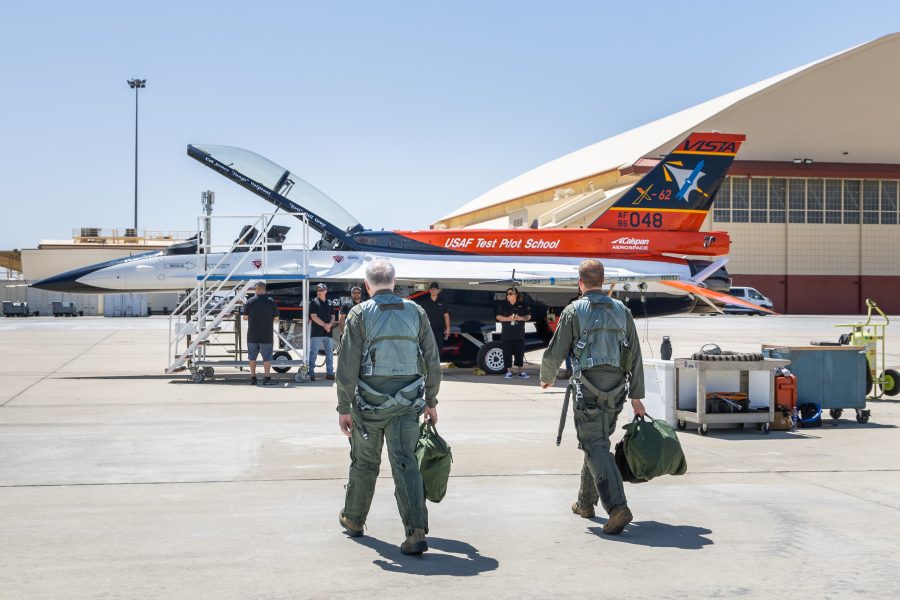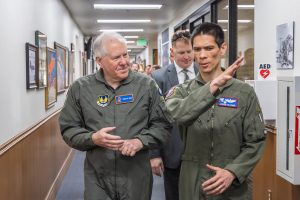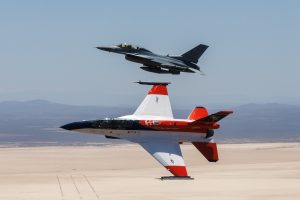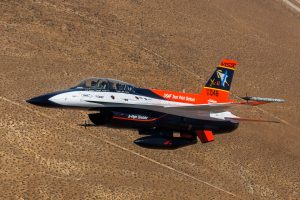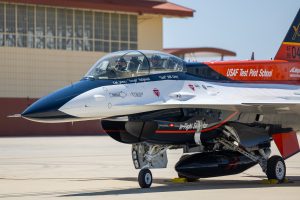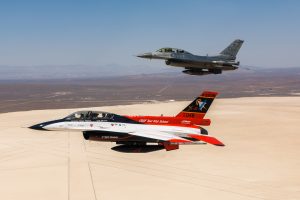Air Force Secretary Frank Kendall caught a ride in the front seat of a modified, artificial intelligence-piloted F-16 on May 2, a high-profile show of confidence in the service’s autonomous technologies—and another key step in maturing that technology for the Collaborative Combat Aircraft program.
Reporters from the Associated Press and NBC were invited to observe the flight at Edwards Air Force Base, Calif., where Kendall spent an hour in the X-62 VISTA, reportedly reaching speeds exceeding 550 miles per hour and coming within 1,000 feet of a second, human-controlled F-16 to test the AI’s proficiency with aerial dogfighting.
Neither Kendall nor the safety pilot in the backseat touched the jet’s controls during the entire journey, according to an Air Force release.
“The potential for autonomous air-to-air combat has been imaginable for decades, but the reality has remained a distant dream up until now,” Kendall said in a release. “This is a transformational moment, all made possible by breakthrough accomplishments of the Air Combat Evolution team.”
Kendall’s willingness to fly with the experimental technology, even as it engaged with another aircraft, “is demonstrating his confidence and faith in the AI agent to do some dynamic maneuvering in that environment against another fighter,” Heather Penney, senior resident fellow at the Mitchell Institute for Aerospace Studies and a former F-16 pilot, told Air & Space Forces Magazine.
But more than that, Penney said, the flight shows the Air Force’s AI is steadily making the transition from simulations to real-world scenarios, which will be crucial for CCAs—envisioned as autonomous “wingmen” drones that will fly alongside manned platforms.
“The physical world is far more complex, and there are enough differences in the air data, such as humidity or winds, for example, that make the transition from simulation to the physical world very difficult,” Penney said. “To be able to use those aircraft sensors to inform the AI agent to make the decisions, and then maneuver in real world, is a significant step towards fielding CCA capability that can be useful in combat.”
The Air Force has been pushing forward on autonomy as of late, with the VISTA program as just one of several feeding into the CCA initiative. The VENOM project, for example, is exploring manned-unmanned teaming with a half-dozen F-16s at Eglin Air Force Base in Florida.
The F-16 is particularly well-suited for such tests, Penney said, as its digital flight control system can integrate the AI agent on board and is highly maneuverable, which helps with testing the agent’s ability to make rapid decisions in dynamic environments.
Strengthening the AI’s decision-making is key to building pilots’ trust in it and integrating CCAs into formations, and Penney suggested an iterative, “crawl-walk-run” approach.
“The CCA capability is not going to be as robust as a human, because humans can make decisions and through the fog and friction of war through ambiguity, uncertainty, deception and deceit,” said Penney. “That is very difficult for AI agents at this point in time.”
Even so, the ability for CCAs to maneuver alongside manned fighters will give the Air Force “affordable mass” to deal with near-peer adversaries like China. These AI-piloted aircraft could serve as force multipliers, enhancing sensor and weapon deployment in contested regions and increasing the survivability of crewed stealth aircraft.
“It’s about disrupting our adversary, creating chaos, depleting the weapons magazine so we can fundamentally shift the risk calculus such that combat operations are in our favor,” Penney said.
Last month, the Air Force selected Anduril and General Atomics to continue developing their CCA concepts. A final source selection for the first increment of CCA will be announced in 2026. The service plans to build at least 1,000 and as many as 2,000 CCAs through the mid-2030s.
And while Kendall’s F-16 ride generated plenty of headlines now, Penney said many more AI-related milestones and flight tests will come in the not-so-distant future.
“In the coming years, we should be able to see early test flights of Increment 1 CCAs, proving and maturing their tactics, and potentially being integrated into manned operational exercises,” said Penney. “Because we also need to learn what is the best way to employ these, and the only way to do that is to experiment through exercises.”
